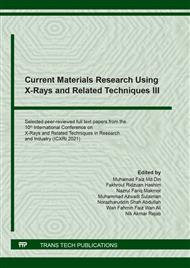[1]
P. Zhao, S. Kim, S. Yoon, and P. Song, Characteristics of indium zinc oxide/silver/indium zinc oxide multilayer thin films prepared by magnetron sputtering as flexible transparent film heaters,, Thin Solid Films, vol. 665, no. April, p.137–142, (2018).
DOI: 10.1016/j.tsf.2018.09.018
Google Scholar
[2]
P. Silva-Bermudez, G. Ramirez, and S. E. Rodil, Corrosion resistant coatings for dental implants. (2013).
DOI: 10.1533/9780857098603.3.250
Google Scholar
[3]
E. Çiftyürek, K. Sabolsky, and E. M. Sabolsky, Platinum thin film electrodes for high-temperature chemical sensor applications,, Sensors Actuators, B Chem., vol. 181, p.702–714, (2013).
DOI: 10.1016/j.snb.2013.02.058
Google Scholar
[4]
E. Chason, T. M. Mayer, and M. Mayer, Critical Reviews in Solid State and Materials Sciences Thin film and surface characterization by specular X-ray reflectivity Thin Film and Surface Characterization by Specular X-Ray Reflectivity, vol. 22, no. September 2013. (1997).
DOI: 10.1080/10408439708241258
Google Scholar
[5]
R. J. Matyi et al., The international VAMAS project on X-ray reflectivity measurements for evaluation of thin films and multilayers - Preliminary results from the second round-robin,, Thin Solid Films, vol. 516, no. 22, p.7962–7966, (2008).
DOI: 10.1016/j.tsf.2008.04.004
Google Scholar
[6]
M. Birkholz, Thin Film Analysis by X-Ray Scattering. (2006).
Google Scholar
[7]
X-ray Diffraction & Elemental Analysis,, p.2015, (2015).
Google Scholar
[8]
N. Habibi, Preparation of biocompatible magnetite-carboxymethyl cellulose nanocomposite: Characterization of nanocomposite by FTIR, XRD, FESEM and TEM,, Spectrochim. Acta - Part A Mol. Biomol. Spectrosc., vol. 131, p.55–58, (2014).
DOI: 10.1016/j.saa.2014.04.039
Google Scholar
[9]
A. Sharma, J. Tripathi, S. Tripathi, and K. C. Ugochukwu, Investigation of magnetic and structural properties of Au capped Fe thin films,, Phys. B Condens. Matter, vol. 560, no. June 2018, p.81–84, (2019).
DOI: 10.1016/j.physb.2019.02.040
Google Scholar
[10]
G. Feng, L. Wu, and J. Letey, Evaluating aeration criteria by simultaneous measurement of oxygen diffusion rate and soil-water regime,, Soil Sci., vol. 167, no. 8, p.495–503, (2002).
DOI: 10.1097/00010694-200208000-00001
Google Scholar


